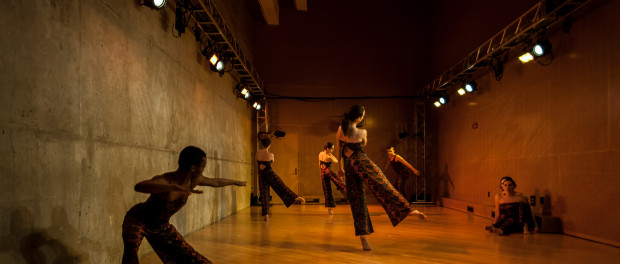On the Threshold of Memory: Interview with Mariah Steele of Quicksilver Dance
Quicksilver Dance heads to the Montreal Fringe Festival this June, bringing a show entitled Tempest in a Teacup that includes five performances with themes ranging from tea to evolution to the fragments of memory. Based in Cambridge, Massachusetts, this is Quicksilver’s first international tour and visit to Montreal as a group of eight dancers. Choreographer and Artistic Director Mariah Steele invited us in to her creative process for a little preview.
Althea Wilson-Forbes (AW): Quicksilver Dance has been around since 2011. How have you expanded in the last few years?
Mariah Steele (MS): In the beginning, we used to do mostly solos and duets, and then in 2011, we took on more group work. The main thing about expanding into group work is finding the right dancers. At first, we chose people based on availability, but over time we created an interview and audition process around the question of, “What are your interests outside of dance?” People who have another passion besides dance allow us to see if there’s compatibility before we actually start working, since the work is such a group effort.
AW: Once selected, where do most of your dancers come from and where have they trained?
MS: All of our dancers have years’ worth of experience in ballet and/or modern dance, and I try to give recent college graduates a chance so that there’s a wider range of ages and professional experience. It’s always great to see a younger dancer’s potential come to life while a veteran dancer can also step up to take on more responsibility within the company.
AW: Are the dancers heavily involved in developing the choreography?
MS: When I’m directing, it’s a mixture of collaboration and set phrasing for the dancers to follow. Like in one piece about evolution, there’s the first section of set phrases, the middle section is a mixture of partnering and improvisation, and the third section is a blend of the two. So I’d say for that piece, it was 60% phrasing and 40% material from the dancers, which led to some interesting discussions when it came time to pick the music. Everyone had their favorite!
AW: Speaking of music, your Montreal performances will be at the Conservatoire de musique, in their acoustic-designed multimedia space.
MS: Four out of the five dances for the Fringe will have accompanying music. We’re going to have a tech rehearsal there, but I haven’t actually heard the music in that space yet.
AW: So how does the layout of the performance space influence the dances?
MS: Well, we come from a main space that’s deep but narrow across. The dancers are really used to its dimensions, so when we started rehearsing for Montreal, we had to adjust because we realized we had more space! We have a big annual show in April every year, so in terms of rehearsal time, that’s helped to give us a lot of early prep for pieces that are newer and haven’t been performed as much.
AW: Each piece is between 8 to 10 minutes long, so will there be transitions from one theme to the next?
MS: I think they each represent a different world naturally. Basically, I create pieces that reflect larger ideas that I’m interested in, like the cultural history of tea or the cycle of life, and so from one dance to the next, hopefully there’s enough ideas in the movements for everyone to connect to.
Quicksilver Dance’s show Tempest in a Teacup is at the St-Ambroise Fringe Festival at 8:15 p.m. on June 14, 2 p.m. on June 15, 9:45 p.m. on June 16, 8:15 p.m. on June 18, and 4:30 p.m. on June 19 at Venue 11 – Studio Multimedia (4750 Henri-Julien), 8$.











